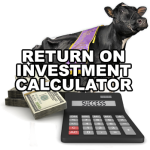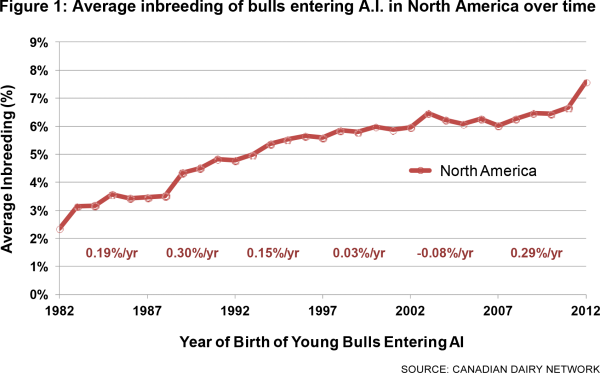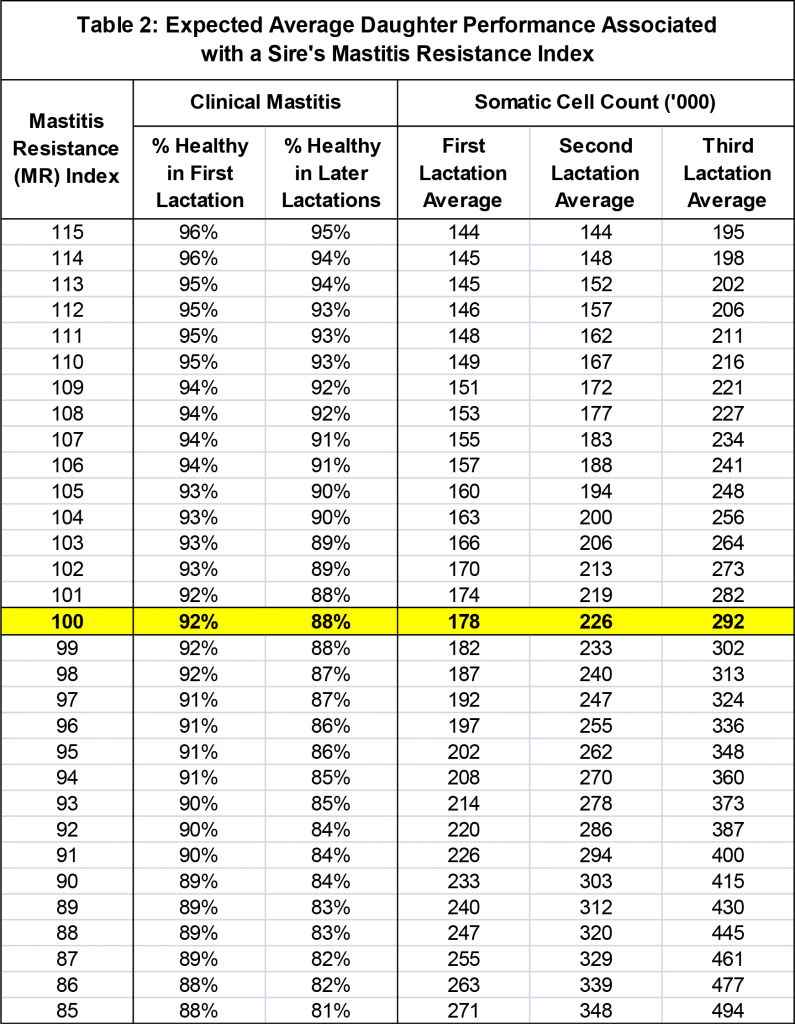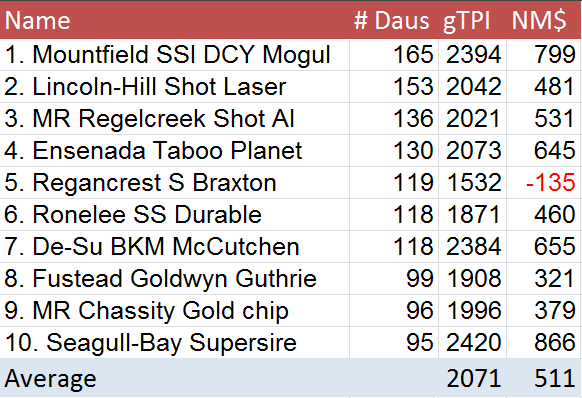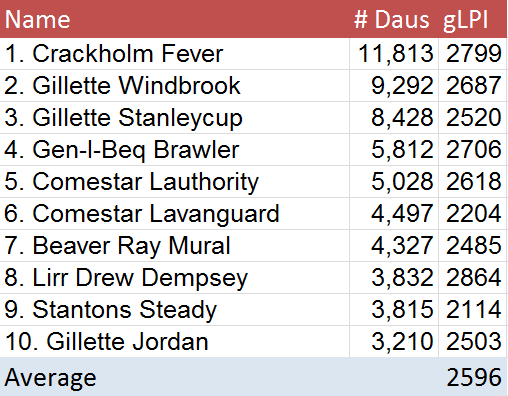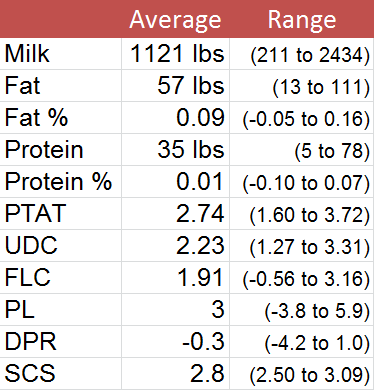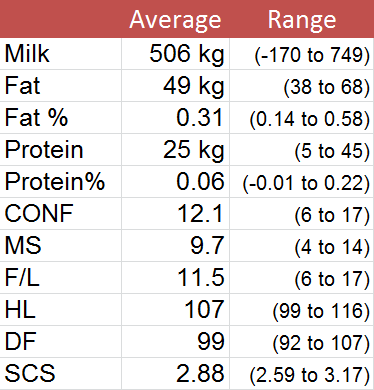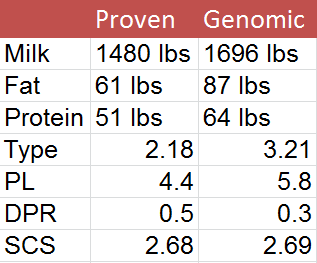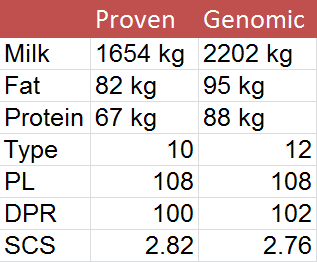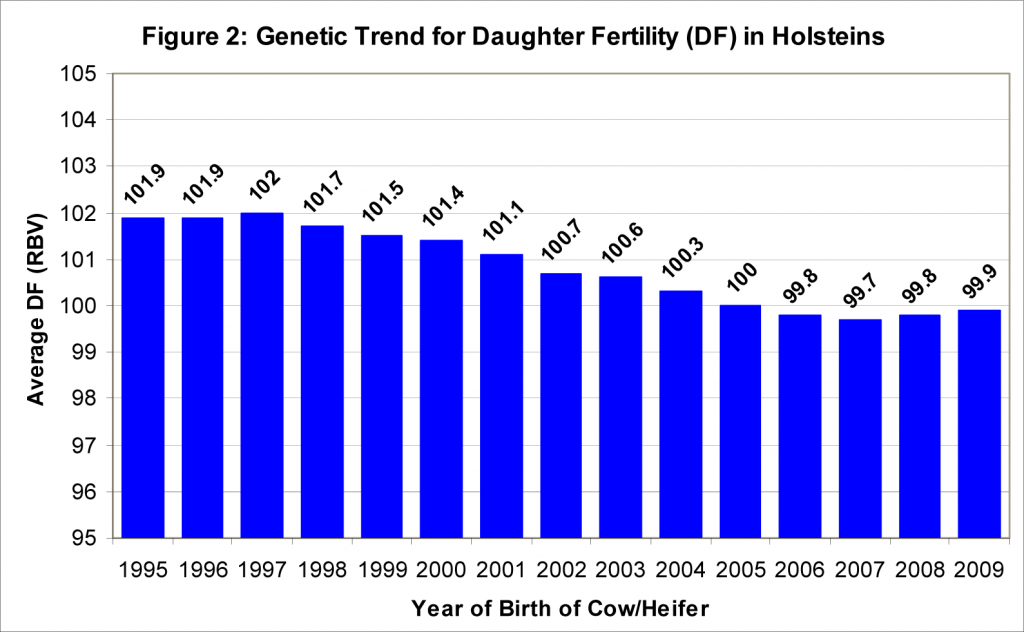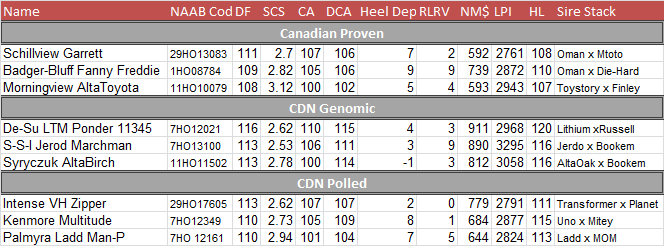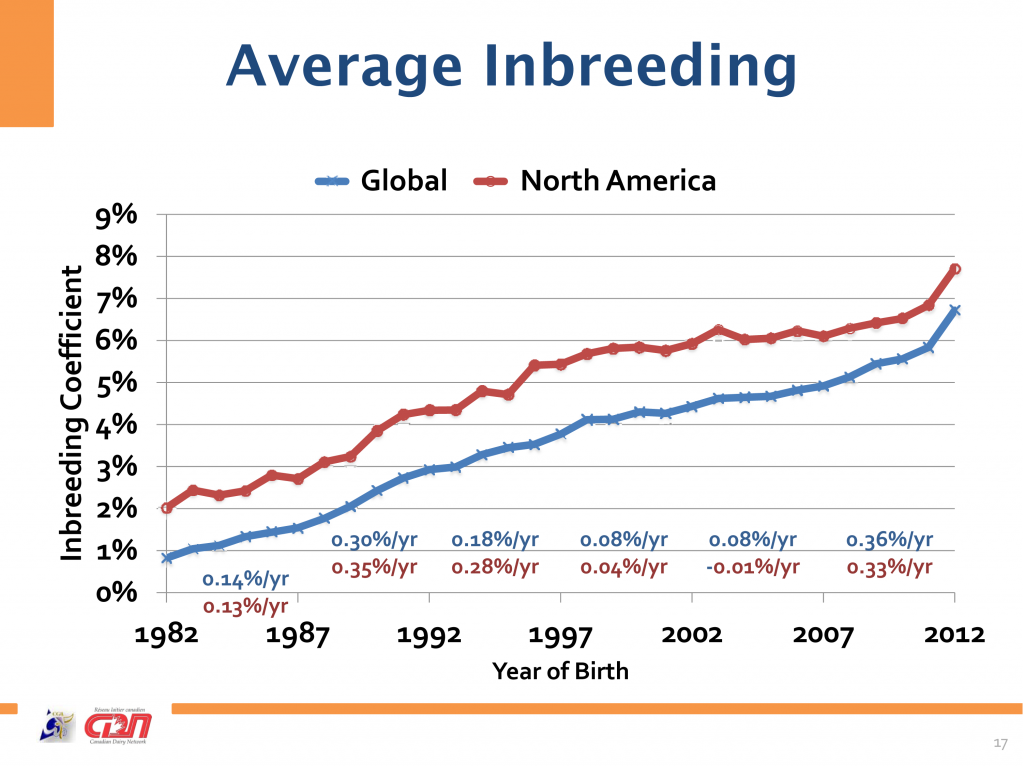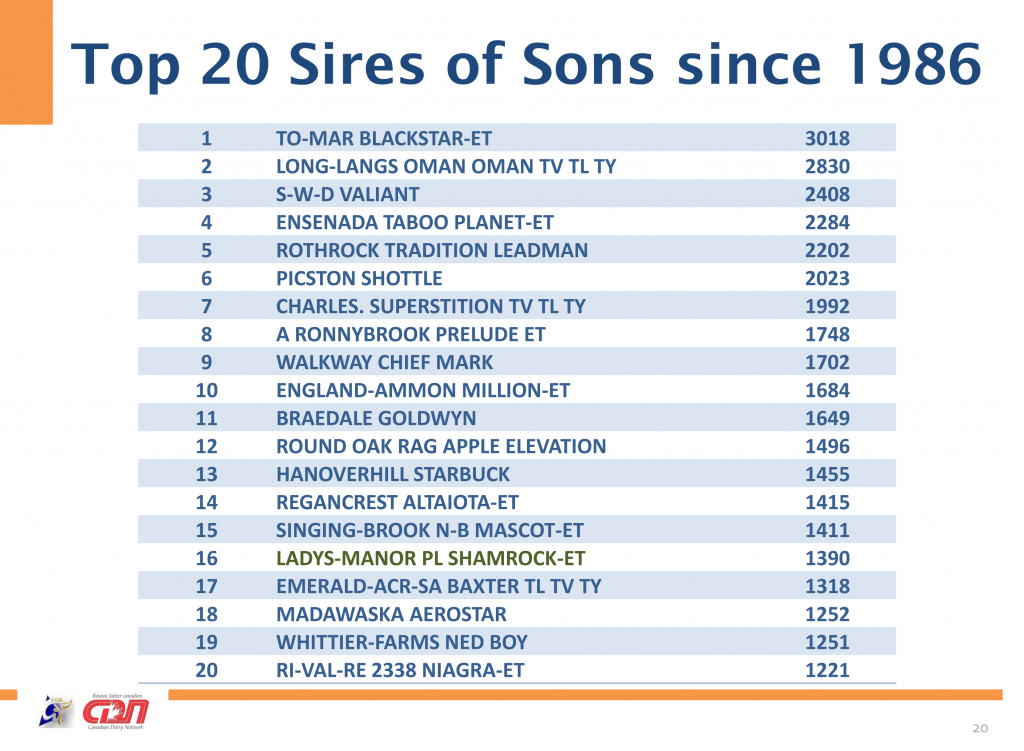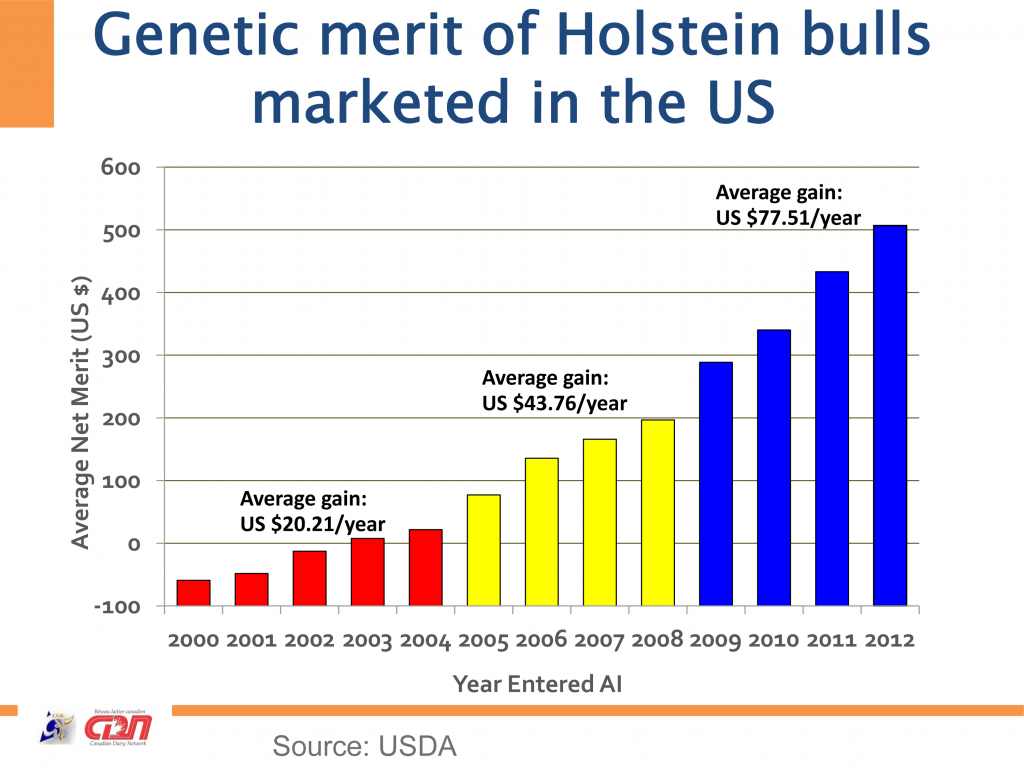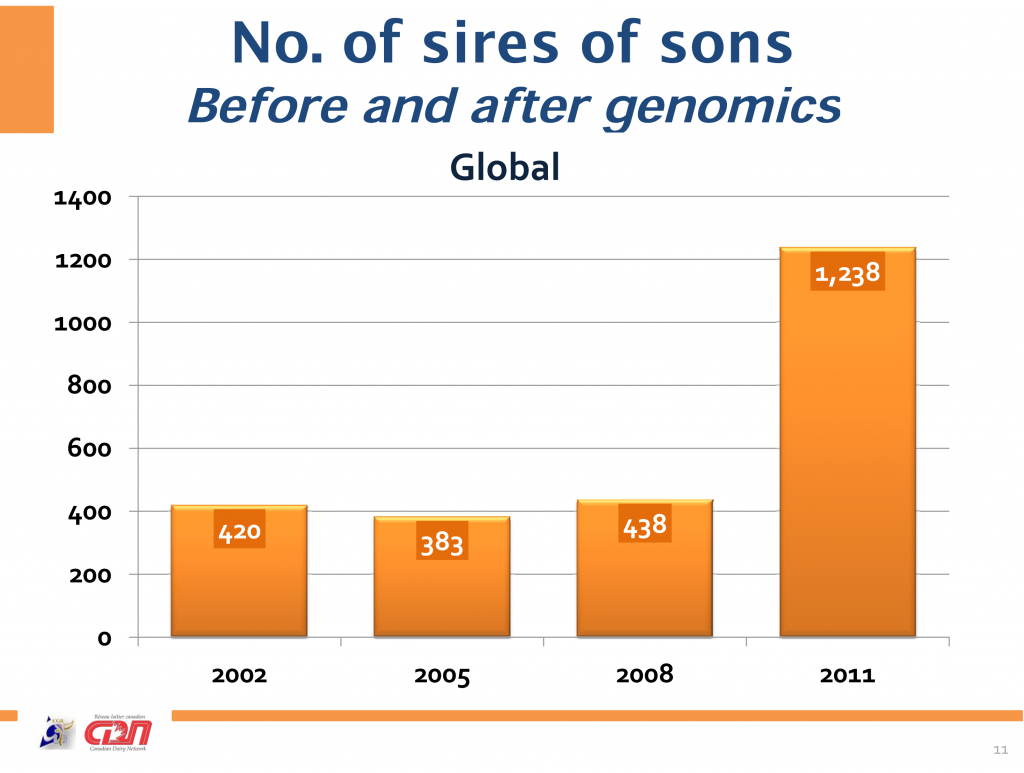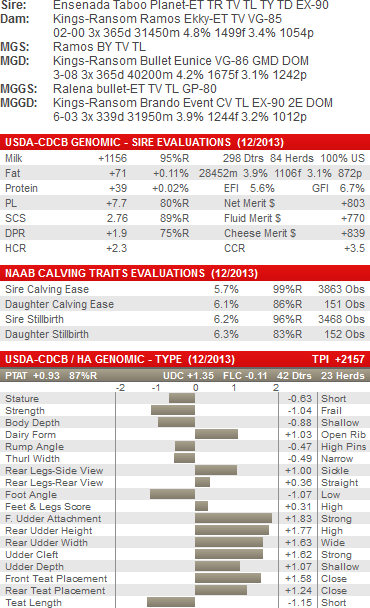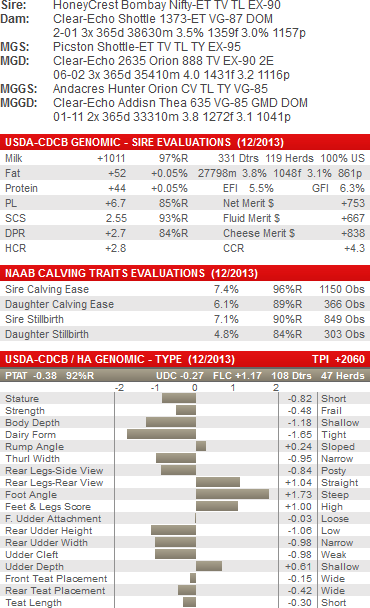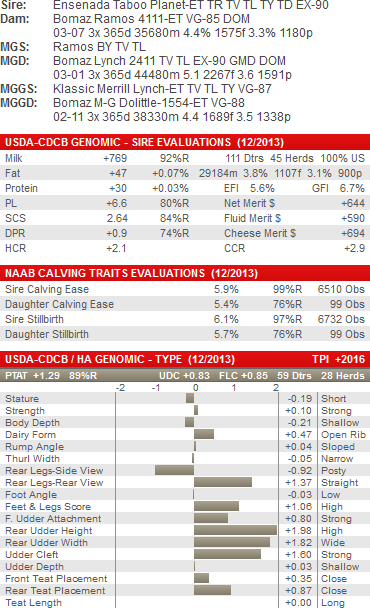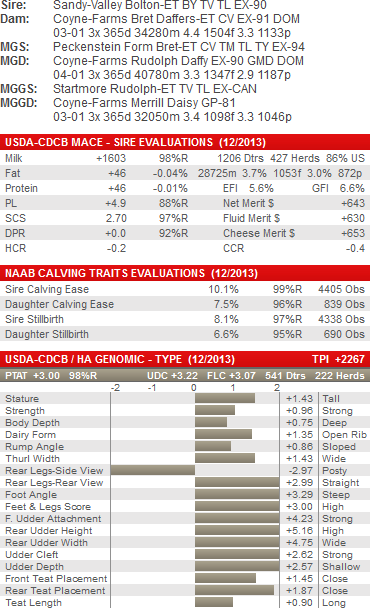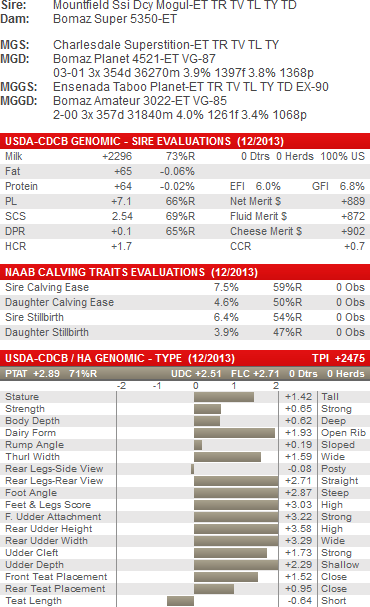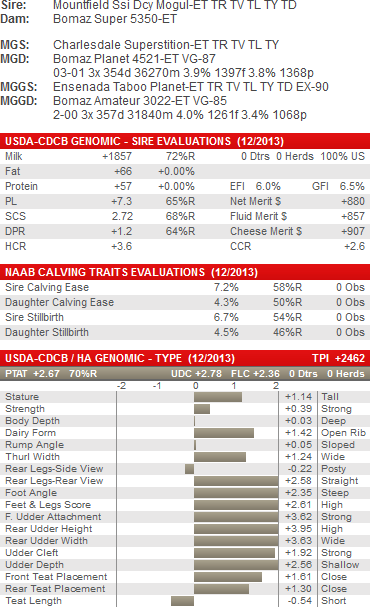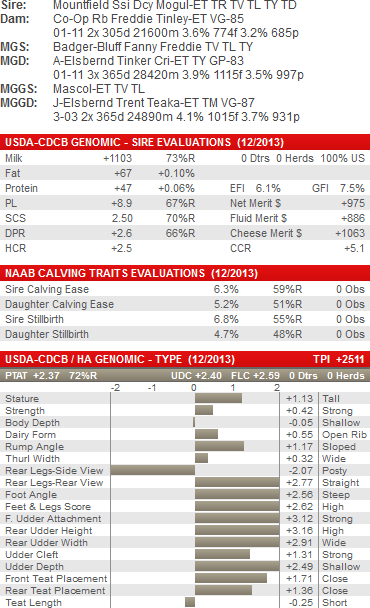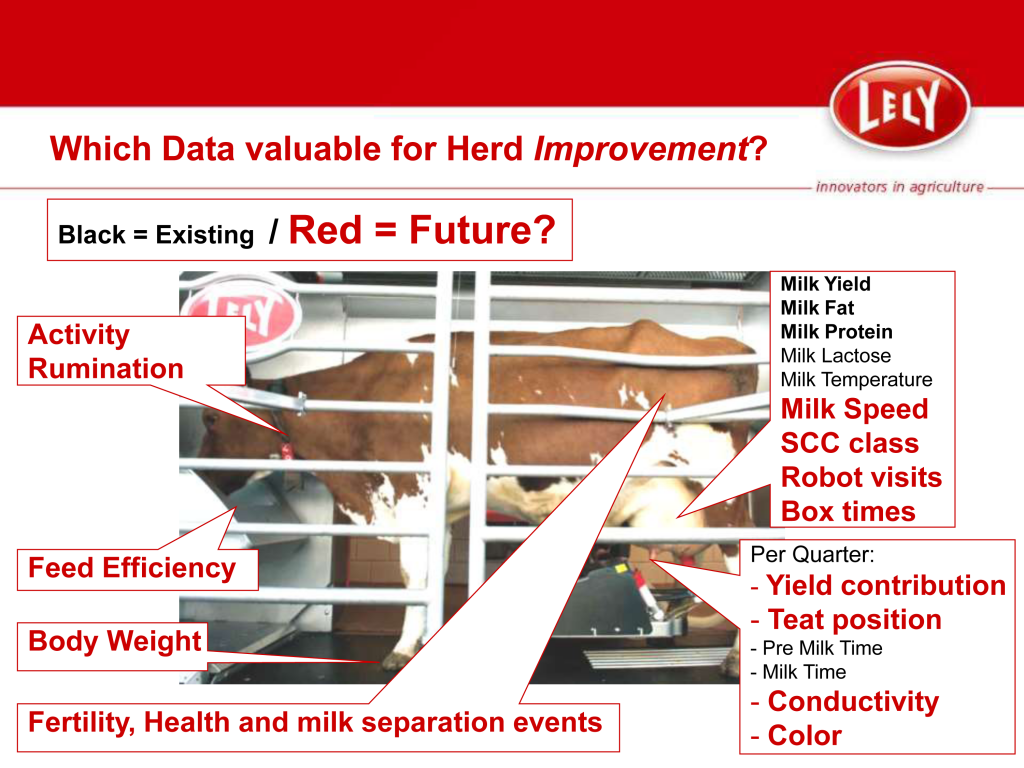| MAPEL WOOD SUPER GOOD LOOKING | 3525 | SUPERSIRE | OCONNORS PLANET LUCIA |
| BOMAZ ALTAOAK 6013 | 3490 | ALTAOAK | BOMAZ OBSERVER 5406-ET |
| SULLY MAN-O-SHAN MARTHA-ET | 3487 | SHAN | SULLY PLANET MANITOBA-ET |
| GILLETTE SUPERSIRE DRIVE | 3481 | SUPERSIRE | GILLETTE M O M DRIVE |
| FARNEAR MASCALESE 1719 | 3454 | MASCALESE | FARNEAR-TBR-BH CASHER-ET |
| SIEMERS MCCUTCH ROZ-ET | 3441 | MCCUTCHEN | CHERRY CREST MANOMAN ROZ |
| EDG LACI SHOTGLASS 766-ET | 3437 | SHOTGLASS | FARNEAR-TBR-BH LACI-ET |
| AIJA SUPERSIRE MAKEA | 3435 | SUPERSIRE | AIJA MAN O MAN NAOMI |
| RI-VAL-RE EHARDT NIK-ET | 3434 | EARNHARDT P | RI-VAL-RE OBSRVR NIKKI-ET |
| BOMAZ ALTAOAK 6023 | 3433 | ALTAOAK | MS ROSYLANE OBSERVR5048-ET |
| EDG DAHLIA MOGUL 2257 | 3425 | MOGUL | LADYS-MANOR S DAHLIA-ET |
| COOKIECUTTER AOAK HAWAII-ET | 3422 | ALTAOAK | COOKIECUTTER MOM HALO-ET |
| EDG 4858 MOGUL 2240-ET | 3411 | MOGUL | PINE-TREE 4233 OBSRV4858-ET |
| MS DELICIOUS CASHCALL | 3405 | CASHCOIN | MISS OCD ROBST DELICIOUS-ET |
| WISSELVIEW SUPER S CHEVELLE | 3388 | SUPERSIRE | LARCREST CHEVELLE-ET |
| AIJA SUPERSIRE NATALIA | 3379 | SUPERSIRE | AIJA MAN O MAN NAOMI |
| COMESTAR LAUSY SUPERSIRE | 3377 | SUPERSIRE | COMESTAR LAUTAMIRE PLANET |
| S-S-I MOONRY LEIGHA 9081-ET | 3369 | MOONRAY | S-S-I KRAMER LOY 7675-ET |
| RI-VAL-RE SYMP VIVIAN-ET | 3369 | SYMPATICO | SONRAY-ACRES SOC OBSERVR VI |
| EDG RUBY EARN 2259 | 3366 | EARNHARDT P | SANDY-VALLEY ROBUST RUBY-ET |
| SIEMERS S-SIRE ROZANNE-ET | 3364 | SUPERSIRE | SIEMERS WINDBK ROZANNE-ET |
| DUHOVENT SUPERSIRE LOVE ME ET | 3363 | SUPERSIRE | GEN-I-BEQ EVOLVE LOVELY |
| MORMANN MOGUL TATUM 2307 | 3358 | MOGUL | FARNEAR-REGAN M TEBBI-ET |
| GREENLANE SUPERSIRE SAIGE | 3356 | SUPERSIRE | MISTY SPRINGS OMAN SATIN |
| STE ODILE LIGHTSNOW PLAISANCE | 3356 | LIGHTSNOW | STE ODILE MANOMAN MOD PLATINE |
| SUNNYLODGE SUPERSIRE SCARLETT | 3356 | SUPERSIRE | MISTY SPRINGS OMAN SATIN |
| FARNEAR MASCALESE 1720 | 3355 | MASCALESE | FARNEAR-TBR-BH CASHER-ET |
| EVELINA | 3352 | SUPERSIRE | NOVA SHOTTLE EVELYN-ET |
| MS DELICIOUS CASHDAY | 3352 | CASHCOIN | MISS OCD ROBST DELICIOUS-ET |
| DESLACS SUPERSIRE PETUNIA | 3345 | SUPERSIRE | FARNEAR-TBR WANNA PARTY-ET |
| MS KOOL COIN 2291 | 3335 | CASHCOIN | MS C-HAVEN OMAN KOOL-ET |
| GREENLANE SUPERSIRE SUSANNA | 3334 | SUPERSIRE | MISTY SPRINGS OMAN SATIN |
| COOKIECUTTER LETIT HAVED-ET | 3331 | LET IT SNOW | COOKIECUTTER MOM HALO-ET |
| FARNEAR HEADLINER 1722 | 3328 | HEADLINER | FARNEAR-TBR-BH MADDY-ET |
| MS KOOL CC 2279 | 3327 | CASHCOIN | MS C-HAVEN OMAN KOOL-ET |
| MS KOOL COIN 2286 | 3325 | CASHCOIN | MS C-HAVEN OMAN KOOL-ET |
| COOKIECUTTER LETIT HAIKU-ET | 3323 | LET IT SNOW | COOKIECUTTER MOM HALO-ET |
| EDG SHAKER DAY 2276 | 3323 | DAY | MS MOVIESTAR SHAKER-ET |
| ROORDA MAY MCBABY 15866-ET | 3318 | MAYFIELD | ROORDA OB MCKENZIE 15267-ET |
| MS DELICIOUS CASHTREE | 3317 | CASHCOIN | MISS OCD ROBST DELICIOUS-ET |
| EDG LORETTE MASC 2230-ET | 3317 | MASCALESE | VELTHUIS SNOWMAN LORRETTE |
| LATUCH SUPER LABELLA-ET | 3313 | SUPERSIRE | LATUCH MAN O LEMMON |
| COOKIECUTTER PRED HAZARD-ET | 3313 | PREDESTINE | COOKIECUTTER MOM HALO-ET |
| CEDARWAL SUPERSIRE BALTI | 3308 | SUPERSIRE | CEDARWAL GERARD BALI |
| EDG LACY COIN 2293 | 3307 | CASHCOIN | KELLERCREST MANOMAN LACY-ET |
| HEBERTVIEW SUPERSIRE DELIGHT | 3304 | SUPERSIRE | NAU CALIBER AMEWILL |
| FLINT-VILLE UNO YESTER-ET | 3300 | NUMERO UNO | COYNE-FARMS OBSERVER YES-ET |
| DESGRANGES MOGUL OBSESSION | 3297 | MOGUL | DESGRANGES MAN O MAN OBAMA ET |
| MS AMERICA LAITICIA-ET | 3296 | LATIMER | SEAGULL-BAY MISS AMERICA-ET |
| LARCREST COLLAGE-ET | 3289 | NUMERO UNO | LARCREST CALE-ET |
| FARNEAR-TBR-BH CASE 2273 | 3285 | SHOTGLASS | LARCREST CASE-ETS |
| DONNANDALE HEADLINER JAZZFLUTE | 3284 | HEADLINER | DONNANDALE MANOMAN JAKARTA |
| BOMAZ MOGUL 6010 | 3281 | MOGUL | BOMAZ BOOKEM 5402-ET |
| LARCREST CICADA-ET | 3278 | NUMERO UNO | LARCREST CALE-ET |
| WILLSBRO MERIDIAN PAMMY-ET | 3278 | MERIDIAN | WILLSBRO PAMMY MAN-O-MAN |
| EDG CAITLYN DOORMAN 2274 | 3278 | DOORMAN | MS CHASSITY SNOW CAITLYN-ET |
| BRYHILL SUPLEX MYSTIQUE-ET | 3273 | ALTASUPLEX | SULLY ROBUST 720-ET |
| EDG LORETTE MOGUL 2260 | 3269 | MOGUL | VELTHUIS SNOWMAN LORRETTE |
| SIEMERS HLINER ROZ-IS-IT-ET | 3267 | HEADLINER | CHERRY CREST MANOMAN ROZ |
| MAPEL WOOD MASCALESE LUXURY | 3266 | MASCALESE | OCONNORS PLANET LUCIA |
| SULLY MAN-O-SHAN MAE-ET | 3265 | SHAN | SULLY PLANET MANITOBA-ET |
| EDG SATURN SHOT 2238-ET | 3262 | SHOTGLASS | SEAGULL-BAY SHAUNA SATURN |
| SIEMERS SSIRE ROZANNERAE-ET | 3262 | SUPERSIRE | SIEMERS WINDBK ROZANNE-ET |
| EDG CHRISTA LATIMER 2226-ET | 3259 | LATIMER | LANGS-TWIN-B CHRISTA-ET |
| AIJA SUPERSIRE MARLO | 3257 | SUPERSIRE | AIJA MAN O MAN NAOMI |
| MOREL IREN | 3257 | LEXOR | ELDORADO |
| LARCREST CIABATTA-ET | 3251 | NUMERO UNO | LARCREST CALE-ET |
| BUTLERVIEW LET IT SHINE-ET | 3251 | LET IT SNOW | VISION-GEN SHO A12024-ET |
| BOMAZ ALTAOAK 6014 | 3249 | ALTAOAK | BOMAZ OBSERVER 5406-ET |
| WILLSBRO MOGUL S AMBER | 3248 | MOGUL | RIVERDANE SHOTTLE AMBER |
| GANDY OBSERVER PARADISE ET | 3246 | OBSERVER | GANDY COLETTE ET |
| EDG BYSHA CC 2258 | 3243 | CASHCOIN | REGANCREST DGR BRYSHA-ET |
| AMMON FARMS STG MYALEXIS-ET | 3243 | SHOTGLASS | AMMON FARMS OSVR MYLILAC-TW |
| FARNEAR MASCALESE 1705 | 3243 | MASCALESE | FARNEAR-TBR-BH CASHER-ET |
| MATT-DARI SUPERSI MAIZIE-ET | 3240 | SUPERSIRE | FUSTEAD AL MARSH-MELLO-ET |
| BLUMENFELD RAN BRIZA CRI-ET | 3237 | RANSOM | DA-SO-BURN OBS BANEAT-ET |
| DE-SU MOCHA 2702-ET | 3232 | MOCHA | DE-SU 1140-ET |
| ALL.NURE SUPERSIRE ALEXIA ET | 3231 | SUPERSIRE | ALTA ET |
| WILLSBOR MOGUL AMBER | 3231 | MOGUL | RIVERDANE SHOTTLE AMBER |
| BOGHILL MOGUL S FAITH ET | 3230 | MOGUL | BOGHILL SUPERSTITION FAITH ET |
| GENERVATIONS MASCALESE LOLITA | 3229 | MASCALESE | GENERVATIONS MOM LOLA |
| TJR ARITA MCCUT 2256 | 3229 | MCCUTCHEN | MS ARIEL MOMAN ARITA-ET |
| WALKERBRAE SS BETHANY | 3228 | SUPERSIRE | FRIESO SHOTTLE APPLE BLOSSOM |
| EDG ETTY MOGUL 2248-ET | 3226 | MOGUL | WELCOME BOOKEM ETTY-ET |
| S-S-I MOONRY LEONIE 9082-ET | 3223 | MOONRAY | S-S-I KRAMER LOY 7675-ET |
| ROYAL HILL MCCUTCHEN SPARKY | 3223 | MCCUTCHEN | ROYAL HILL MANOMAN SPARKY |
| MS DELICIOUS SINGER 764-ET | 3223 | SHOTGLASS | MISS OCD ROBST DELICIOUS-ET |
| RICKLAND SUPERSIRE 4593-ET | 3221 | SUPERSIRE | HAMMER-CREEK SNO KASSIE-ET |
| ZIMMERVIEW MORGAN BRINA-ET | 3221 | MORGAN | ROCKYPATH-HO MN BARBARA-ET |
| ALL.NURE SUPERSIRE ASIA ET | 3220 | SUPERSIRE | ALTA ET |
| CO-OP SPS PRUDENCE 7080-ET | 3218 | SUPERSIRE | MS M-P DOLCE PRUDENCE-ET |
| NH SUPERSIRE REALTIME | 3218 | SUPERSIRE | KALB |
| RI-VAL-RE SUPERSIRE NADOLA | 3217 | SUPERSIRE | RI-VAL-RE DOLCE DESTINY-ET |
| MORMANN LAT TABINE 2297-ET | 3214 | LATIMER | FARNEAR-REGAN TALSA-ET |
| MS AMERICA BRENDA-ET | 3213 | BEN | SEAGULL-BAY MISS AMERICA-ET |
| FARNEAR CASHCOIN 1718 | 3212 | CASHCOIN | FARNEAR ALICE OF ADEEN-ET |
| EDG LACY SHOT 2232-ET | 3212 | SHOTGLASS | KELLERCREST MANOMAN LACY-ET |
| PREMIERWEST SUPERSIRE CANCUN | 3207 | SUPERSIRE | LARCREST CHEVELLE-ET |
| BOMAZ SUPERSIRE 6005 | 3207 | SUPERSIRE | BOMAZ IOTA 5423-ET |
| HIGHERRANSOM COIN STITCH-ET | 3206 | CASHCOIN | BRU-DALE MOM STARLY-ET |
| EDG ESTHER EARN 2245-ET | 3206 | EARNHARDT P | MILLER-FF BOOKEM ESTHER-ET |
| EDG LORETTE MASC 2225-ET | 3205 | MASCALESE | VELTHUIS SNOWMAN LORRETTE |
| HOS-COT RANSOM PEARL-ET | 3204 | RANSOM | WELCOME MAN-O-MAN PAYOUT-ET |
| CCC MOGUL SPECIAL | 3203 | MOGUL | |
| CO-OP SPS PRUDENCE 7079-ET | 3200 | SUPERSIRE | MS M-P DOLCE PRUDENCE-ET |
| BUTLERVIEW TJR SNOW 13 | 3199 | LET IT SNOW | ROCKING-P BOWSER LUNA-ET |
| SPRUCE-HAVEN MCCUTCHEN 14660 | 3198 | MCCUTCHEN | SPRUCE-HAVEN SUPR S13158-ET |
| 3198 | EARNHARDT P | PINE-TREE 2149ROBST 4846-ET |
| ALEXERIN MASCALESE 1366 | 3198 | MASCALESE | ALEXERIN OMAN 993 |
| DES-Y-GEN HUNTER SAVANA | 3197 | HUNTER | DES-Y-GEN PLANET SILKY |
| WISSELVIEW SUPERSIRE COSMO | 3197 | SUPERSIRE | LARCREST CHEVELLE-ET |
| WISSELVIEW SUPERSIRE DELILAH | 3197 | SUPERSIRE | LICKBER-I RMH GOLD DAHLIA |
| BOMAZ SUPERSIRE 6008 | 3197 | SUPERSIRE | BOMAZ OMAN 3512 |
| FARNEAR NUMERO UNO 1704 | 3196 | NUMERO UNO | FARNEAR-TBR-BH CASHER-ET |
| S-S-I OLYMIC EBONY 9079-ET | 3191 | OLYMPIC | S-S-I SHAMROCK ELI 7694-ET |
| EDG CASHBUST DOORMAN 2284 | 3191 | DOORMAN | FARNEAR-TBR-BH CASHBUST-ET |
| GOLDEN-OAKS UNO CARLENE-ET | 3191 | NUMERO UNO | RUGG-DOC OBSV CARMINDSAY-ET |
| SAN-DAN SHAN LEONA 2306 | 3189 | SHAN | RICHMOND-FD AL LORELEI-ET |
| EDG LACY SHOT 2246-ET | 3189 | SHOTGLASS | KELLERCREST MANOMAN LACY-ET |
| BRABANTDALE LET IT REIGN | 3188 | LET IT SNOW | SPEEK-NJ MAN OMAN ROCKET-ET |
| BRABANTDALE LET IT REPEAT | 3188 | LET IT SNOW | SPEEK-NJ MAN OMAN ROCKET-ET |
| SIEMERS MCUTCH REAL-GIRL-ET | 3188 | MCCUTCHEN | CLEAR-ECHO OBSERVER 2283-ET |
| EDG JALA MOGUL 2267 | 3188 | MOGUL | BUTLERVIEW SR JEVEN JALA-ET |
| S-S-I OLYMP LATONYA 9073-ET | 3188 | OLYMPIC | TIGER-LILY SHAMROCK LENA-ET |
| ALNA SUPERSIRE BEATRICE | 3187 | SUPERSIRE | SIEMERS SNMAN BEJEWELED-ET |
| MAPEL WOOD MCCUTCHEN LOGAN | 3186 | MCCUTCHEN | OCONNORS PLANET LUCIA |
| SANDY-VALLEY SUPRSIRE BO-ET | 3185 | SUPERSIRE | SANDY-VALLEY BODACIOUS-ET |
| EDG ESTHER LEXOR 2285 | 3185 | LEXOR | MILLER-FF BOOKEM ESTHER-ET |
| COMESTAR LAMADONA DOORMAN | 3185 | DOORMAN | COMESTAR LAUTAMAI MAN O MAN |
| WILLSBRO MOGUL PAMMY | 3185 | MOGUL | WILLSBRO NIAGRA PAMMY |
| GOLDEN-OAKS MAY MAJESTA-ET | 3185 | MAYFIELD | GOLDEN-OAKS ROBUST MABEL-ET |
| SUNNYLODGE SPOTTIE | 3184 | LET IT SNOW | MISTY SPRINGS MAN O MAN SATIN |
| FARNEAR MASCALESE 1707 | 3183 | MASCALESE | FARNEAR-TBR-BH CASHER-ET |
| EDG STITCH COIN 2295 | 3182 | CASHCOIN | GRAN-J RUSSELL STITCH-ET |
| CO-OP SPS SIBELLA 7122-ET | 3180 | SUPERSIRE | FUSTEAD SIBELLA CRI-ET |
| EDG LACY SHOT 2253 | 3179 | SHOTGLASS | KELLERCREST MANOMAN LACY-ET |
| TJR ARITA MCCUT 2270 | 3179 | MCCUTCHEN | MS ARIEL MOMAN ARITA-ET |
| MATCREST GALAXY CHARLEE-ET | 3178 | GALAXY | MATCREST IOTA COLORADO-ETS |
| HARTFORD ELECTN SARA 423-ET | 3178 | ELECTION | GNAT-HILL ROBUST ANDREA-ET |
| ALPHAGEN MCCUTCHEN MARINA | 3174 | MCCUTCHEN | GITOISE JAKE MARIZA |
| SNOWBIZ SYMPATICO SYLVANA | 3174 | SYMPATICO | GEN-I-BEQ SNOWMAN SPRING |
| SIEMERS HLINER ROZ-THE-1-ET | 3174 | HEADLINER | CHERRY CREST MANOMAN ROZ |
| EDG LORETTE MOGUL 2251 | 3173 | MOGUL | VELTHUIS SNOWMAN LORRETTE |
| MORSAN UNO CRIMSON | 3173 | NUMERO UNO | LARCREST CINERGY-ET |
| MS SUPERSIRE B 3432-ET | 3173 | SUPERSIRE | MISTY SPRINGS SHOTTLE BREEZE |
| CO-OP BOXER TOPAZ-ET | 3170 | BOXER | MS PRIDE PLNT TASKET 788-ET |
| EDG GIN RANSOM 783 | 3169 | RANSOM | SULLY HART GERARD 147-ET |
| SUNNYLODGE SUPERSIRE SOPHIA | 3168 | SUPERSIRE | MISTY SPRINGS OMAN SATIN |
| WELCOME SUPERSIRE LEOTA | 3166 | SUPERSIRE | WELCOME BAXTER LAILA-ET |
| OCONNORS MCCUTCHEN LUSCIOUS | 3166 | MCCUTCHEN | OCONNORS PLANET LUCIA |
| SIEMERS SSIRE ROZANNEMAE-ET | 3165 | SUPERSIRE | SIEMERS WINDBK ROZANNE-ET |
| MS SIZZLE CASHCOIN 772-ET | 3165 | CASHCOIN | VENTURE SHOTTBOLT SIZZLE P |
| EDG DAHLIA MOGUL 2264 | 3164 | MOGUL | LADYS-MANOR S DAHLIA-ET |
| MATT-DARI SUPERSI MARNI-ET | 3163 | SUPERSIRE | FUSTEAD AL MARSH-MELLO-ET |
| S-S-I MSCLS MADELENA9089-ET | 3161 | MASCALESE | S-S-I COBRA MADIGAN 7614-ET |
| CEDARWAL NUMEROUNO CHROME | 3161 | NUMERO UNO | LARCREST CALLAWAY-ET |
| SNOWBIZ MASCALESE LILA | 3160 | MASCALESE | CALBRETT SNOWMAN LANDI |
| MORMANN UNO ARABIA-ET | 3160 | NUMERO UNO | VISION-GEN SH FRD A12304-ET |
| 3160 | EARNHARDT P | WEIGELINE OBSERVER 1869-ET |
| NO-FLA MAURICE SAR 35024-ET | 3160 | MAURICE | NO-FLA OBSERVER SANDY 30510 |
| CO-OP SPS 6292 7118-ET | 3157 | SUPERSIRE | CO-OP CLARK YOYO 6292-ET |
| EDG ABYSS DOORMAN 2288 | 3156 | DOORMAN | RMW SNOWMAN ABYSS-ET |
| DG FANATIC LORRY-ET | 3156 | | VEN DAIRY LIDIA 4 |
| INTENSE OBSERVER 1239-ET | 3154 | OBSERVER | COMYN-PBCD SPLENDID-ET |
| BOMAZ MOGUL 5979 | 3154 | MOGUL | BOMAZ BOOKEM 5402-ET |
| CLAYNOOK DRESSY SYMPATICO | 3153 | SYMPATICO | OCD PLANET DIAMOND-ET |
| SULLY RANSOM MARLY-ET | 3153 | RANSOM | SULLY PLANET MANITOBA-ET |
| MS LATIMER MUSICAL-ET | 3152 | LATIMER | MISS TMK ROBUST MUGSY-ET |
| CEDARWAL SUPERSIRE SWEET | 3152 | SUPERSIRE | CEDARWAL SUGA MOMMA |
| EDG ABYSS UNO 779 | 3150 | NUMERO UNO | RMW SNOWMAN ABYSS-ET |
| SANDY-VALLEY KRNCH TOPSY-ET | 3148 | KRUNCH | SANDY-VALLEY IOTA TOPAZ-ET |
| 3148 | PREDESTINE | COOKIECUTTER MOM HALO-ET |
| 548077799-ET | 3147 | | VEN DAIRY LIDIA 4 |
| SUNNYLODGE SHARLENE | 3147 | LET IT SNOW | MISTY SPRINGS MAN O MAN SATIN |
| EDG GERARD LITHIUM 2252 | 3145 | LITHIUM | SULLY HART GERARD 147-ET |
| WILLSBRO YORIK PAMMY | 3144 | YORICK | WILLSBRO PAMMY MAN-O-MAN |
| RI-VAL-RE SUPERSIRE DAY-ET | 3144 | SUPERSIRE | RI-VAL-RE SUPER NADINE-ET |
| BRYHILL SUPLEX MADALENA-ET | 3143 | ALTASUPLEX | SULLY ROBUST 720-ET |
| EDG ESTHER EARN 2247-ET | 3143 | EARNHARDT P | MILLER-FF BOOKEM ESTHER-ET |
| SANDY-VALLEY SWEETDREAMS-ET | 3142 | SUPERSIRE | SANDY-VALLEY DAY DREAM-ET |
| MORSAN SS ELLA | 3141 | SUPERSIRE | LOOKOUT PESCE SM ELLA |
| CLAYNOOK BRADLEE DOORMAN | 3140 | DOORMAN | MISTY SPRINGS M O M BACARDI |
| GREENVALLEY K&L MO DORIA | 3139 | MOGUL | REGAN-ALH PLANET DELORIA-ET |
| MARBRI MASCALISE BRISTLE | 3138 | MASCALESE | MARBRI BAXTER BREEZE |
| FARNEAR MASCALESE 1706 | 3137 | MASCALESE | FARNEAR-TBR-BH CASHER-ET |
| WEBB-VUE PREDESTINE 6909-ET | 3137 | PREDESTINE | WEBB-VUE DOMAIN RHONDA-ET |
| MS SUPERSIRE B 3423-ET | 3137 | SUPERSIRE | MISTY SPRINGS SHOTTLE BREEZE |
| BO-IRISH-RN SS CHARTER | 3137 | SUPERSIRE | BO-IRISH-RN SUPER CHARM-ET |
| PREMIERWEST MOGUL CAMELLIA | 3136 | MOGUL | LARCREST CHEVELLE-ET |
| FARNEAR CASHCOIN 1717 | 3136 | CASHCOIN | FARNEAR ALICE OF ADEEN-ET |
| T-SPRUCE SUPERSIRE 7472 | 3136 | SUPERSIRE | LANGS-TWIN-B PEARL-ET |
| WELCOME-TEL MASSEY LIOLA-ET | 3135 | MASSEY | KELLERCREST SUPER LIESL-ET |
| SNOWBIZ SYMPATICO SAL | 3135 | SYMPATICO | GEN-I-BEQ SNOWMAN SUMMER |
| S-S-I PRED MADDIE 9088-ET | 3133 | PREDESTINE | S-S-I PEOTI MASH 7739-ET |
| COOKIECUTTER ALOAK HALEX-ET | 3133 | ALTAOAK | COOKIECUTTER MOM HALO-ET |
| EDG STITCH CC 2280 | 3133 | CASHCOIN | GRAN-J RUSSELL STITCH-ET |
| EDG BRYSHA COIN 2262 | 3133 | CASHCOIN | REGANCREST DGR BRYSHA-ET |
| MILLER-FF HEAD ELLIE-ET | 3133 | HEADLINER | MILLER-FF RAVISH ELINOR-ET |
| CEDARWAL LET IT EXPLODE | 3132 | LET IT SNOW | WABASH-WAY BOLTON EMERY-ET |
| RI-VAL-RE SYMP ESCAPADE-ET | 3132 | SYMPATICO | RI-VAL-RE SOTO ESCAPADE-ET |
| COOKIECUTTER PRE HANDFUL-ET | 3132 | PREDESTINE | COOKIECUTTER MOM HALO-ET |
| GO-FARM ECSTASSY ET | 3131 | FERNAND | GO-FARM ESTER ET |
| WSA COSMO-ET | 3131 | MOGUL | AJDH ASMARA |
| EDG TRAC SHOT 2261 | 3131 | SHOTGLASS | TRANQUILLITY AC DREARYS TRACE |
| AMMON FARMS MASEY MYLASS-ET | 3130 | MASSEY | AMMON FARMS OBSVR MYLILY-TW |
| MORSAN HUNTER M ROBIN | 3130 | HUNTER | ROCKYMOUNTAIN METEOR ROBIN |
| FABEL MARIE CIEL MOGUL | 3130 | MOGUL | SYMA IOTA MARIE LUNE |
| EDG ADEEN MASCALESE 2148 | 3129 | MASCALESE | FARNEAR READY FOR ADEEN-ET |
| WEBB-VUE SHOTGLASS 6913-ET | 3129 | SHOTGLASS | WEBB-VUE SHAMROCK KAYLA-ET |
| FARNEAR MASCALESE 1721 | 3129 | MASCALESE | FARNEAR-TBR-BH CASHER-ET |
| MORSAN SUPERSIRE M ALICIA | 3128 | SUPERSIRE | MORSAN MANOMAN G ALICIA |
| MISS MCCUTCHEN JAMACIA-ET | 3128 | MCCUTCHEN | MACLAND ATWOOD JULIET |
| TIGER-LILY SHAMROCK LENA-ET | 3128 | SHAMROCK | TIGER-LILY DEANN LEANN |
| TRUSTMORE MOGUL LISA ET | 3127 | MOGUL | VELTHUIS PLANET LIZZY |
| KINGS-RANSOM SHAN DIXA-ET | 3126 | SHAN | KINGS-RANSOM IOTA DRAMA-ET |
| CONNY | 3126 | SHAMROCK | MON-COPABOKA |
| BOMAZ MOGUL 5983 | 3125 | MOGUL | BOMAZ FREDDIE 5368 |
| EDG STITCH COIN 2290 | 3124 | CASHCOIN | GRAN-J RUSSELL STITCH-ET |
| MORMANN LAT TRANGA 2301 | 3120 | LATIMER | FARNEAR-REGAN TALSA-ET |
| MS AMERICA BINETTE-ET | 3118 | BEN | SEAGULL-BAY MISS AMERICA-ET |
| EDG CASHBUST SNOW 2237-ET | 3118 | LET IT SNOW | FARNEAR-TBR-BH CASHBUST-ET |
| G M R DORCY ROZIE | 3116 | DORCY | CHERRY CREST MANOMAN REBECA |
| ALL.NURE NUMERO UNO PIA ET | 3116 | NUMERO UNO | ALL.NURE SUPER POLLY ET |
| GOLDEN-OAKS MAY MADNESS-ET | 3115 | MAYFIELD | GOLDEN-OAKS ROBUST MABEL-ET |
| EDG RUBY EARNHARDT 2242-ET | 3114 | EARNHARDT P | SANDY-VALLEY ROBUST RUBY-ET |
| RIVER-BRIDGE SAJAC RACH-ET | 3113 | SAJAC | CO-OP RB OBSR RACHEL-ET |
| EDG MIKI SNOW 2118-ET | 3113 | LET IT SNOW | AMMON-PEACHEY SUPER MIKI-ET |
| KINGS-RANSOM PRED DEBBIE-ET | 3112 | PREDESTINE | KINGS-RANSOM DORC DEXTRA-ET |
| LARCREST CINNABAR-ET | 3112 | NUMERO UNO | LARCREST CALE-ET |
| 3112 | EARNHARDT P | PINE-TREE 2149ROBST 4846-ET |
| MORMANN MOGUL TIMELY 2315 | 3110 | MOGUL | FARNEAR-REGAN M TEBBI-ET |
| SAN-DAN SHAN LIZA 2298 | 3108 | SHAN | RICHMOND-FD AL LORELEI-ET |
| MALIC PONDE ELISA | 3107 | LITHIUM | PONDE FREDDIE EMIE |
| BOMAZ MOGUL 5978 | 3107 | MOGUL | BOMAZ BOOKEM 5402-ET |
| APRILDAY-CG SS LARAINA-ET | 3107 | SUPERSIRE | TIGER-LILY LAUGH PP-RED-ET |
| WILLSBRO MERIDIAN AMBER-ET | 3107 | MERIDIAN | RIVERDANE SHOTTLE AMBER |
| EDG HALLE MCCUT 2117-ET | 3107 | MCCUTCHEN | B&Z PLANET 7807 HALLE-ET |
| FARNEAR-TBR-BH BRONO 2172 | 3106 | BRONO | B-ENTERPRISE SUPER GIGI-ET |
| ZAHBULLS OAK ETA | 3105 | ALTAOAK | BLUE-HORIZON PLAN EDITH-ET |
| SAN-DAN MOGUL SASSY 2312 | 3104 | MOGUL | UFM-DUBS SHERUN-ET |
| MS AMERICA LAILA-ET | 3103 | LATIMER | SEAGULL-BAY MISS AMERICA-ET |
| BOMAZ ALTAOAK 6016 | 3103 | ALTAOAK | BOMAZ OBSERVER 5406-ET |
| WESTENRADE CARRERA 1-ET | 3102 | MOGUL | WESTENRADE CARRERA |
| EDG BRYSCHA MOGUL 2263 | 3102 | MOGUL | MS FARNEAR BRCDE BRYSCHA-ET |
| MARIE MCCUTCHEN CHANEL | 3102 | MCCUTCHEN | GILLETTE IOTA CORVETTE |
| ROSYLANE-LLC MAURICE5975-ET | 3101 | MAURICE | MS ROSYLANE OBSERVR5109-ET |
| ALL.NURE NUMERO UNO PAULA ET | 3100 | NUMERO UNO | ALL.NURE SUPER POLLY ET |
| BONACCUEIL EARNHARDT KATHE | 3098 | EARNHARDT P | BONACCUEIL SNOWMAN CASSIE |
| BOMAZ ALTAOAK 6017 | 3098 | ALTAOAK | MS ROSYLANE OBSERVR5048-ET |
| MORSAN UNO CINERGY | 3097 | NUMERO UNO | LARCREST CINERGY-ET |
| AMMON-PEACHEY LR MISS PRISS | 3097 | LATIMER | AMMON-PEACHEY B MISCHIEF-ET |
| WILLSBRO UNO CLASSY | 3095 | NUMERO UNO | KOEPON SUPER CLASSY 70 |
| WILLSBRO MOGUL N PAMMY | 3095 | MOGUL | WILLSBRO NIAGRA PAMMY |
| CO-OP SPS 6292 7124-ET | 3093 | SUPERSIRE | CO-OP CLARK YOYO 6292-ET |
| CO-OP UPD GALAXY 6570-ET | 3092 | GALAXY | CO-OP UPD DOMAIN 4510-ET |
| CO-OP UPD GALAXY 6565-ET | 3090 | GALAXY | CO-OP UPD DOMAIN 4510-ET |
| 3090 | FRANKINSTEIN | WEIGELINE OBSERVER 1869-ET |
| S-S-I MYSTIC KACI 9075-ET | 3088 | MYSTIC | S-S-I CONSTANTINE O 7628-ET |
| RI-VAL-RE SYMP AUBURN-ET | 3087 | SYMPATICO | SONRAY-ACRES SOC OBSERVR VI |
| WILLSBRO S MERIDIAN PAMMY-ET | 3087 | MERIDIAN | WILLSBRO PAMMY MAN-O-MAN |
| DINOMI LTMR SARA 9735-ET | 3086 | LATIMER | DINOMI PLANET SEXY |
| JEANLU UNO BEAUTY | 3086 | NUMERO UNO | FARNEAR BROCADES BEA-ET |
| LESPEREE ETERNITY GERRY | 3084 | ETERNITY | LESPEREE MANIFOLD GESTRIE |
| EDG BRYSHA COIN 2265 | 3082 | CASHCOIN | REGANCREST DGR BRYSHA-ET |
| JK EDER COOSJE-ET | 3082 | | JK EDER CINDERELLA |
| CO-OP LEXOR SAMARA 7120-ET | 3081 | LEXOR | WELCOME-TEL OBSER SAMARA-ET |
| MS SUPERSIRE B 3420-ET | 3081 | SUPERSIRE | MISTY SPRINGS SHOTTLE BREEZE |
| GOLDEN-OAKS-I MAYFIELD CARMEN | 3080 | MAYFIELD | RUGG-DOC OBSV CARMINDSAY-ET |
| SPRINGHILL-OH M WHISPER-ET | 3079 | MORGAN | SPRINGHILL-OH DORCY WANDA |
| CLAYNOOK DRAMA SYMPATICO | 3078 | SYMPATICO | OCD PLANET DIAMOND-ET |
| SNOWBIZ MCCUTCHEN DEE | 3078 | MCCUTCHEN | BROEKS DAISY-ET |
| SAN-DAN LEXOR CRUSH 2320-ET | 3078 | LEXOR | MS CHASSITY OBS CRYSTAL-ET |
| STE ODILE LIGHTSNOW PLEIADES | 3077 | LIGHTSNOW | STE ODILE MANOMAN MOD PLATINE |
| SPRUCE-HAVEN LEXOR 14682 | 3076 | LEXOR | POTTERS-FIELD BOJA 9853-ET |
| BROEKS COTY-ET | 3075 | O-COSMOPOLITAN | BROEKS BETTY |
| MORSAN MAYFIELD M ROBIN | 3075 | MAYFIELD | ROCKYMOUNTAIN METEOR ROBIN |
| DES-Y-GEN LIGHTSNOW SANDY | 3075 | LIGHTSNOW | DES-Y-GEN WINDBROOK SLIKY |
| DUDOC EARNHARDT ACCOLADE | 3072 | EARNHARDT P | PARAMOUNT-MB OBSRV AKELA-ET |
| EDG STITCH CC 2278 | 3070 | CASHCOIN | GRAN-J RUSSELL STITCH-ET |
| SAN-DAN LEX CANDICE 2318-ET | 3069 | LEXOR | MS CHASSITY OBS CRYSTAL-ET |
| ALPHAGEN MCCUTCHEN MARIZIE | 3069 | MCCUTCHEN | GITOISE JAKE MARIZA |
| JES-ET MOGUL PETUNIA | 3069 | MOGUL | MS C-HAVEN GERARD PANDA-ET |
| HOS-COT RANSOM PALE-ET | 3068 | RANSOM | WELCOME MAN-O-MAN PAYOUT-ET |
| BRYHILL SUPLEX MARLEE-ET | 3068 | ALTASUPLEX | SULLY ROBUST 720-ET |
| DPR EARNHARDT PARTY P | 3067 | EARNHARDT P | WINDSOR-MANOR ZSH PANDA-ET |
| CEDARWAL LET IT ELECTRIFY | 3066 | LET IT SNOW | WABASH-WAY BOLTON EMERY-ET |
| MS EMILY HARMONY-ET | 3066 | HEADLINER | TRAMILDA-N BAXTER EMILY-ET |
| GITOISE ETERNITY MAGUY | 3065 | ETERNITY | GITOISE JAKE MALY |
| CALBRETT MASCALESE LEAH | 3065 | MASCALESE | CALBRETT GOLDWYN LAYLA-ET |
| EDG BRYSHA EPIC 8090-ET | 3064 | EPIC | REGANCREST DGR BRYSHA-ET |
| FARNEAR-TBR-BH 2156-ET | 3063 | BRONO | B-ENTERPRISE SUPER GIGI-ET |
| ROSYLANE-LLC MAURICE5965-ET | 3063 | MAURICE | MS ROSYLANE OBSERVR5109-ET |
| VANHAVEN MASC R SANDIE | 3063 | MASCALESE | NAVS M SHARLA-ET |
| BRABANTDALE HDLINER ROCKLAND | 3063 | HEADLINER | SPEEK-NJ MAN OMAN ROCKET-ET |
| GLASSON NUMERO UNO G GLORA | 3062 | NUMERO UNO | GLASSON JD GOLDWYN GLORA ET |
| SAN-DAN SHEGULL 2314 | 3062 | MOGUL | UFM-DUBS SHERUN-ET |
| CALBRETT MASCALESE LASS | 3061 | MASCALESE | CALBRETT GOLDWYN LAYLA-ET |
| QUIET-BROOK-D PRE HOTROD-ET | 3058 | PREDESTINE | COOKIECUTTER MM HALLMARK-ET |
| MATT-DARI MAURICE DARSANO | 3058 | MAURICE | MATT-DARI OBSERVER DOLLY-ET |
| GOLDEN-OAKS SPRS MARTINI-ET | 3058 | SUPERSIRE | SIEMERS EXPLD MARGARITA-ET |
| BOGHILL MOGUL S FAITH B ET | 3057 | MOGUL | BOGHILL SUPERSTITION FAITH ET |
| GILLETTE MASCALESE SNOOP | 3055 | MASCALESE | GILLETTE S PLANET 2ND SNOOZE |
| 2371402530-ET | 3055 | MASSEY | HOOD M-O-M EVELYN |
| CO-OP SPS PRUDENCE 7081-ET | 3051 | SUPERSIRE | MS M-P DOLCE PRUDENCE-ET |
| COOKIECUTTER ELECT HOXIE-ET | 3051 | ELECTION | COOKIECUTTER MOM HULA-ET |
| JOSEY-LLC EARNHART SILLY-ET | 3051 | EARNHARDT P | DES-Y-GEN PLANET SILK |
| MILLER-FF MASC EVADOO-ET | 3051 | MASCALESE | NOVA SHOTTLE EVELYN-ET |
| CALBRETT LET IT SNOW EVE | 3050 | LET IT SNOW | EVER-GREEN-VIEW ETA-ET |
| DE-SU DAY 2688-ET | 3050 | DAY | DE-SU 1112-ET |
| COOKIECUTTER AOAK HASLET-ET | 3050 | ALTAOAK | COOKIECUTTER MOM HALO-ET |
| MORMANN LAT TAFFY 2295-ET | 3050 | LATIMER | FARNEAR-REGAN TALSA-ET |
| NH MASCALESE FANTASTICA | 3050 | MASCALESE | NH SUPER FRANCHISE |
| SUNTOR SS LASHES | 3049 | SUPERSIRE | SUNTOR MAN O MAN LEANNE |
| CO-OP UPD GALAXY 6298-ET | 3049 | GALAXY | CO-OP UPD RAMOS 3430 |
| HAH SUDAN PATRON | 3049 | SUDAN | WELCOME BRONCO PATRON |
| COMESTAR LILACATE WORLDWIDE | 3049 | WORLDWIDE | COMESTAR LILACATHY SNOWMAN |
| RUH MERIDIAN ANIQUE | 3047 | MERIDIAN | AMIDA |
| JIMTOWN LEXOR NARTANA-ET | 3045 | LEXOR | JIMTOWN OBSERVER NIZAH-ET |
| VANHAVEN MASC R SHARLIZE | 3045 | MASCALESE | NAVS M SHARLA-ET |
| JOSEY-LLC EARNHART SPOCK-ET | 3044 | EARNHARDT P | DES-Y-GEN PLANET SILK |
| BOGHILL CM FAITH A ET | 3043 | CM | BOGHILL SUPERSTITION FAITH ET |
| BO-IRISH-RN MOG BIGWIG-ET | 3043 | MOGUL | REGANCREST GOLD BRETTA-ET |
| EDG ETTY MOGUL 2243-ET | 3043 | MOGUL | WELCOME BOOKEM ETTY-ET |
| CO-OP UPD GALAXY 6319-ET | 3042 | GALAXY | CO-OP UPD RAMOS 3430 |
| DREBERT MERIDIAN AZIMUT | 3041 | MERIDIAN | DREBERT MAGNETISM AZOULE |
| AIJA SUPERSIRE MYA | 3041 | SUPERSIRE | AIJA MAN O MAN NAOMI |
| DEER-BROOK PEOTI 3711 | 3040 | PEOTI | DEER-BROOK GERARD 3204-TW |
| 3040 | NUMERO UNO | |
| 3040 | NUMERO UNO | |
| SYLVANSIDE LEXOR LISA | 3040 | LEXOR | FLEURY GEN BAXTER LISA |
| MS EMILY HYPER BALLAD-ET | 3039 | HEADLINER | TRAMILDA-N BAXTER EMILY-ET |
| BUTZ-HILL DOT MASSY 2249-ET | 3039 | MASSEY | SPEEK-NJ SNOW DOTTIE RAE-ET |
| WILLSBRO FERNAND LILA Z-ET | 3039 | FERNAND | WILLSBRO SHOTTLE HOW LILA Z |
| SNOWBIZ MCCUTCHEN CHLOE | 3038 | MCCUTCHEN | MS CHASSITY SNOW CARRIE-ET |
| KHW MOGUL AKAKO-ET | 3038 | MOGUL | KHW GOLDWYN AIKO-ET |
| BOMAZ LITHIUM 6002 | 3038 | LITHIUM | BOMAZ ROBUST 5481-ET |
| EDG LILLICO MASC 2229-ET | 3037 | MASCALESE | BOLDI SNOWMAN LILLICO |
| CCC COSMOPOLITAN EXTRA | 3037 | O-COSMOPOLITAN | |
| BRYHILL SUPLEX MICA-ET | 3037 | ALTASUPLEX | SULLY ROBUST 720-ET |
| WILLSBRO MOGUL DIOR RAE | 3036 | MOGUL | WILLSBRO PS DIOR RAE |
| MORSAN SG ALICIA | 3035 | SUPERSIRE | MORSAN MANOMAN G ALICIA |
| ZIMMERVIEW PARDISE SULLY-ET | 3034 | PARADISE | ZIMMERVIEW SUPER SIMONE-ET |
| STE ODILE SUPERSIRE MODEL JAVA | 3033 | SUPERSIRE | STE ODILE MANIFOLD MODEL JADE |
| ROSYLANE-LLC RANSOM 5968 | 3032 | RANSOM | ROSYLANE BOWSER 5146 |
| TELSTAR HUNTER DANELION-ET | 3031 | HUNTER | DINTYS PAUL DIGNITY-ET |
| CROTEAU GALAXY MELBA | 3030 | GALAXY | REGANCREST-I MILLION MELANNY |
| S-S-I SHTGLS SIRENA 9000-ET | 3029 | SHOTGLASS | FUSTEAD DOMAIN SHOPPER-ET |
| BACON-HILL PREDSTNE LEAH-ET | 3029 | PREDESTINE | GOLDEN-OAKS LATTE-ET |
| WILLSBRO MOGUL SHO AMBER | 3029 | MOGUL | RIVERDANE SHOTTLE AMBER |
| GILLETTE CARAMINATOR TINA | 3028 | CARAMINATOR | GILLETTE M O M TAHITI |
| BUTLERVIEW LET IT SUN-ET | 3028 | LET IT SNOW | VISION-GEN SHO A12024-ET |
| CANCO MERIDIAN LOREL | 3028 | MERIDIAN | AMITIES SHOTTLE LOVER |
| BLONDIN MCCUTCHEN AMAZING | 3028 | MCCUTCHEN | RWM SNOW ANGEL-ET |
| GO-FARM KAMERY ET | 3027 | MERCHANDISE | GEGANIA LONAR K |
| BROEKS ENEKEM-ET | 3027 | BOOKEM | MS RYAN-CREST ENERGIZE-ET |
| KAKOUNA GILLESPY CASPY | 3027 | GILLESPY | KAKOUNA DUPLEX CASMY |
| HIGHERRANSOM OAK SILLY-ET | 3026 | ALTAOAK | BRU-DALE MOM STARLY-ET |
| DURESEAU OBLIK BREWMASTER | 3026 | BREWMASTER | DURESEAU OTELLO BOLTON |
| LATUCH PETRONE LIGHT-ET | 3026 | PETRONE | LATUCH OMAN LIBERTY |
| SNOWBIZ SUPERSIRE LYNDSEY | 3026 | SUPERSIRE | CALBRETT SNOWMAN LEXIE |
| UNITED-PRIDE MANDORA 6506 | 3026 | MANDORA | UNITED-PRIDE FREDDIE 4614 |
| DONNANDALE DAY LUVA | 3023 | DAY | DONNANDALE WINDBROOK LYN |
| GEN-I-BEQ MASCALESE ANNSO | 3023 | MASCALESE | KHW-I AIKA BAXTER |
| NH MASCALESE ELENA | 3023 | MASCALESE | NH SNOW ELIGHT |
| ERBCREST PHOENIX MARLENE | 3023 | PHOENIX | ERBCREST DUPLEX MARVELLOUS |
| SYLVANSIDE LEXOR LILA | 3023 | LEXOR | FLEURY GEN BAXTER LISA |
| WELCOME MASCALESE LAUREL-ET | 3023 | MASCALESE | WELCOME O-STYLE LONNIE-ET |
| SUNNYLODGE SINDY | 3022 | LET IT SNOW | MISTY SPRINGS MAN O MAN SATIN |
| CO-OP BOXER APPLE 7069-ET | 3022 | BOXER | RICHLAWN SUPER APRIL APPLE |
| BOMAZ LITHIUM 6027 | 3022 | LITHIUM | BOMAZ BOOKEM 5402-ET |
| INTENSE OBSERVER 1238-ET | 3021 | OBSERVER | COMYN-PBCD SPLENDID-ET |
| FILIALE MOGUL SMARY | 3021 | MOGUL | LESPERRON SHOTTLE SPLENDA |
| SANDY-VALLEY S BOONDOCKS-ET | 3021 | SUPERSIRE | SANDY-VALLEY BODACIOUS-ET |
| UFM-DUBS SHEROHE-ET | 3021 | HEADLINER | UFM-DUBS SHEROW-ET |
| CO-OP UPD GALAXY 6415 | 3021 | GALAXY | CO-OP TRIGG YANCIE 6309-ET |
| SAN-DAN LEXOR CASEY 2319-ET | 3021 | LEXOR | MS CHASSITY OBS CRYSTAL-ET |
| SNOWBIZ SYMPATICO SKY | 3020 | SYMPATICO | GEN-I-BEQ SNOWMAN SPRING |
| CO-OP UPD DAY 6430 | 3020 | DAY | CO-OP UPD GWN 3502-ET |
| CO-OP DD GALAXY 40059-ET | 3020 | GALAXY | CO-OP TRIGG ABIGAIL 6402-ET |
| EDG ETTY MONARCH 2287 | 3019 | MONARCH | WELCOME BOOKEM ETTY-ET |
| MS SIZZLE CASHCOIN 781-ET | 3018 | CASHCOIN | VENTURE SHOTTBOLT SIZZLE P |
| CO-OP PUZZL ROSETTE 7111-ET | 3018 | PUZZLE | CO-OP M-P ATWOOD ROSETTE-ET |
| WILLSBRO MERIDIAN PLEDGE-ET | 3018 | MERIDIAN | WILLSBRO EVOLVE PLEDGE |
| MS AMERICA LOTTERY-ET | 3017 | LATIMER | SEAGULL-BAY MISS AMERICA-ET |
| SPRUCE-HAVEN DESTINED *RC 1465 | 3017 | DESTINED | SPRUCE-HAVEN ROB BS13135-ET |
| CO-OP 7119-ET | 3017 | MAURICE | CO-OP CALIBER MARA 6293-ET |
| CO-OP SPS RAPTUROUS 7082-ET | 3016 | SUPERSIRE | HARMONY-HO SIGNI RAPTUROUS |
| SANDY-VALLEY KRNC TOPEKA-ET | 3016 | KRUNCH | SANDY-VALLEY IOTA TOPAZ-ET |
| EDG RUBY GC REEBA 16 | 3015 | GOLD CHIP | SANDY-VALLEY ROBUST RUBY-ET |
| FARNEAR CASHCOIN 1716 | 3015 | CASHCOIN | FARNEAR ALICE OF ADEEN-ET |
| CREEK MCCUTCHEN HEIDI | 3014 | MCCUTCHEN | CREEK AL HILDA |
| LOTTI-ET | 3014 | | JK EDER GOLDSTAR 2 |
| LEOTHE SUPERSIRE LAURIE | 3013 | SUPERSIRE | LEOTHE BRETT LUCIDE |
| EDG CASHBUST¿GALAXY 2250 | 3012 | GALAXY | FARNEAR-TBR-BH CASHBUST-ET |
| EDG JALA MOGUL 2266 | 3012 | MOGUL | BUTLERVIEW SR JEVEN JALA-ET |
| GITOISE ETERNITY MAGGIE | 3012 | ETERNITY | GITOISE JAKE MALY |
| S-S-I MOONRAY LAURA 9072-ET | 3011 | MOONRAY | S-S-I KRAMER LOY 7675-ET |
| BLONDIN HEADLINER LAUZYA | 3010 | HEADLINER | LESPEREE METEOR LAUZI |
| WILLSBRO BREWMASTER LILA Z | 3009 | BREWMASTER | WILLSBRO PLANET LILA Z |
| DIANA | 3009 | MERIDIAN | DAGGI |
| GLASSON UNO G GLORA | 3009 | NUMERO UNO | GLASSON JD GOLDWYN GLORA ET |
| VEKIS ELSA QUEEN-ET | 3008 | MASSEY | ELTES |
| CEDARWAL SUPERSIRE EDGY | 3008 | SUPERSIRE | WABASH-WAY SHOTTLE ELLYN-ET |
| LOOKOUT PESCE NATASHA | 3007 | HEADLINER | GOLD-N-OAKS O NOVA2269-ET |
| WILLSBRO MERIDIAN PLEDGE 35-ET | 3007 | MERIDIAN | WILLSBRO EVOLVE PLEDGE |
| VICTORIA MASSEY KERRY | 3007 | MASSEY | VICTORIA SUPER KIRBY |
| HYDE-PARK MASSEY 4433 | 3007 | MASSEY | HYDE-PARK ARMY 3584-TW |
| BONACCUEIL EARNHARDT PANAMA P | 3006 | EARNHARDT P | WINDSOR-MANOR ZSH PANDA-ET |
| AIMONETTA UNO LUCY ET | 3005 | NUMERO UNO | OWN GOLD LUCILLE |
| DE OOSTERHOF O HAPPY | 3005 | DADDY | DG EROSHINE FR |
| EDG CASHBUST DOOR 2289 | 3004 | DOORMAN | FARNEAR-TBR-BH CASHBUST-ET |
| SAN-DAN MOGUL SHEMO 2302 | 3003 | MOGUL | UFM-DUBS SHERUN-ET |
| WILLSBRO MERIDIAN ATLEE-ET | 3002 | MERIDIAN | HEAVENLY MOM ATLEE |
| MORMANN LAT TUSKY 2294-ET | 3002 | LATIMER | FARNEAR-REGAN TALSA-ET |
| CASTEL MOGUL TALQUEE ET | 3001 | MOGUL | VIDIA DEMELLO RAVISANTE |
| IDILLY P2M | 3000 | LAVAMAN | G DILLY P2M |
| EDG ETTY UNO 770 | 3000 | NUMERO UNO | WELCOME BOOKEM ETTY-ET |
| CROTEAU DAKKER SALSA | 2999 | DAKKER | GEN-I-BEQ GERARD SAMMY |
| LEOTHE HEADLINER LAURA | 2999 | HEADLINER | LEOTHE BRETT LUCIDE |
| SULLY LITHIUM MARY-ET | 2998 | LITHIUM | SULLY PLANET MANITOBA-ET |
| JEANRI PHOENIX PONPON | 2998 | PHOENIX | JEANRI BOLY PETALE |
| WELCOME-TEL PREDSTN LIZA-ET | 2998 | PREDESTINE | KELLERCREST SUPER LIESL-ET |
| JS MISS MADEIRA-ET | 2997 | DADDY | J.S. MISS MERIBEL |
| WELCOME-TEL RANSOM LEETA-ET | 2997 | RANSOM | KELLERCREST SUPER LIESL-ET |
| POM IERE | 2996 | NUMERO UNO | EGALE POM |
| AMMON FARMS MASY MYLAYLA-ET | 2996 | MASSEY | AMMON FARMS OBSVR MYLILY-TW |
| WILLSBRO N UNO O DOLLY ET | 2995 | NUMERO UNO | WILLSBRO ONWARD DOLLY |
| TRUSTMORE MOGUL LILAC ET | 2995 | MOGUL | VELTHUIS PLANET LIZZY |
| EDG BABY UNO 2228-ET | 2994 | NUMERO UNO | OCONNORS SUPER BABY |
| MATCREST SHAN CHESSA-ET | 2994 | SHAN | MATCREST RADON CRIMSON-ET |
| CLAYNOOK DOWRY SYMPATICO | 2993 | SYMPATICO | OCD PLANET DIAMOND-ET |
| JEANLU MOGUL FIESTA | 2993 | MOGUL | SPEEK-NJ OBSERV FANDANGO-ET |
| SPRUCE-HAVEN PAR SX14654-ET | 2991 | PARKER | SPRUCE-HAVEN OBS SX12849-ET |
| QUIET-BROOK-D MERID FALLAX | 2991 | MERIDIAN | QUIET-BROOK-D BRONCO FALI |
| WILLSBRO A N UNO PAMMY | 2990 | NUMERO UNO | WILLSBRO BAXTER PAMMY ET |
| GITOISE ETERNITY MAGIE | 2990 | ETERNITY | GITOISE JAKE MALY |
| 2990 | PERRY | |
| ALL.NURE MACALESE BELLINA | 2990 | MASCALESE | ALL.NURE SHOTTLE BLUEBELLE ET |
| A-L-H BETHANY | 2989 | LITHIUM | A-L-H PLANET BRIDGET |
| BOMAZ SUPERSIRE 5974 | 2989 | SUPERSIRE | BOMAZ PARKER 5321-ET |
| SYLVANSIDE REGINA MOGUL | 2987 | MOGUL | SYLVANSIDE SHOTTLE REGINA |
| CO-OP LITHIUM 6287 7123-ET | 2986 | LITHIUM | CO-OP CLARK TASKET 6287-ET |
| 2986 | SUPERSIRE | WELCOME JEEVES PERLY-ET |
| RI-VAL-RE EHARDT CHIPS-P-ET | 2986 | EARNHARDT P | RI-VAL-RE OBSRVR SALSA-ET |
| WILLSBRO MERIDIAN E PLEDGE-ET | 2985 | MERIDIAN | WILLSBRO EVOLVE PLEDGE |
| HOOD LEXIA | 2984 | LEXOR | MARWIL LM REBECCA |
| CALBRETT MASCALESE LILLIANNE | 2983 | MASCALESE | CALBRETT GOLDWYN LAYLA-ET |
| RI-VAL-RE DOLO OAKLEY-ET | 2983 | DOLO-P | RI-VAL-RE SUPER NIKE-ET |
| CO-OP UPD GALAXY 6301-ET | 2983 | GALAXY | CO-OP UPD RAMOS 3430 |
| SNOWBIZ GALAXY LUPIN | 2981 | GALAXY | SILVERRIDGE SNOW LIZZY |
| R-E-W LAYNE PINK CRI-ET | 2981 | LAYNE | WABASH-WAY EVES EASY PEA-ET |
| PELLERAT MOGUL SANDY | 2981 | MOGUL | PELLERAT BAXTER SARIE |
| WILLSBRO FERNAND HOW LILA Z-ET | 2980 | FERNAND | WILLSBRO SHOTTLE HOW LILA Z |
| MOREL IDOL | 2980 | LEXOR | ELDORADO |
| CO-OP GRAFEETI GABRIEL 7128 | 2980 | GRAFEETI | JE-KO GABRIEL CRI-ET |
| CO-OP UPD PUZZLE 6484 | 2980 | PUZZLE | COMYN-PBCD SUMMER CRI-ET |
| STE ODILE LIGHTSNOW PACIFICA | 2980 | LIGHTSNOW | STE ODILE MANOMAN MOD PLATINE |
| WILLSBRO MERIDIAN S AMBER-ET | 2979 | MERIDIAN | RIVERDANE SHOTTLE AMBER |
| EDG ABYSS DOORMAN 2281 | 2978 | DOORMAN | RMW SNOWMAN ABYSS-ET |
| SANDY-VALLEY KRN TOPANGA-ET | 2976 | KRUNCH | SANDY-VALLEY IOTA TOPAZ-ET |
| WILLSBRO MERIDIAN SHO LILA Z-E | 2975 | MERIDIAN | WILLSBRO MOM SHO LILA Z |
| SIEMERS SHIMONE 19952 | 2974 | SHIMONE | SIEMERS DORCY 16120 |
| SIEMERS MASCALESE BOMBI-ET | 2974 | MASCALESE | GEN-I-BEQ SHOTTLE BOMBI |
| ST MAYFIELD MAKIO | 2974 | MAYFIELD | GOLDEN-OAKS ROBUST MABEL-ET |
| S-S-I PREDEST SINA 9091-ET | 2974 | PREDESTINE | HAPPYDANNY SNOW STORM-ET |
| ROXY | 2974 | MOGUL | BOUW MOM ROXY |
| K&K GAMES 8727 | 2973 | MOGUL | |
| BOMAZ LITHIUM 6031 | 2973 | LITHIUM | BOMAZ BOOKEM 5402-ET |
| LEOTHE SUPERSIRE DAUPHINE | 2973 | SUPERSIRE | LEOTHE BAXTER DAPHNEE |
| DES-Y-GEN HUNTER SYLKIA | 2972 | HUNTER | DES-Y-GEN PLANET SILKY |
| MILLER-FF MASC EVIE-ET | 2971 | MASCALESE | NOVA SHOTTLE EVELYN-ET |
| CLAYNOOK DIOR SYMPATICO | 2971 | SYMPATICO | OCD PLANET DIAMOND-ET |
| HIGHERRANSOM PRED SALTY-ET | 2970 | PREDESTINE | BRU-DALE MOM STARLY-ET |
| RZH ADELAIDE | 2969 | MAYFIELD | KHW SUPER ADERYN-ET |
| BERGITTE HUNTER HELIA | 2969 | HUNTER | BERGITTE ASHLAR HAVARD |
| 6217686931-ET | 2968 | MOGUL | FOTTO MAE |
| CALBRETT LET IT SNOW LIGHTLY | 2968 | LET IT SNOW | CALBRETT GOLDWYN LAYLA-ET |
| SPRUCE-HAVEN MASSEY 14691 | 2967 | MASSEY | SPRUCE-HAVEN FRED A13182-ET |
| FABEL DELPHIE MERIDIAN | 2967 | MERIDIAN | SYTOMAX DORICE BAHAMAS |
| KINGS-RANSOM PREDES APPLE | 2966 | PREDESTINE | N-SPRINGHOPE NIAGRA ANNA-ET |
| KINGS-RANSOM CASHCN DELL-ET | 2966 | CASHCOIN | KINGS-RANSOM BAXTER DOLLY |
| KINGS-RANSOM KRUNCH EXPERT | 2965 | KRUNCH | KINGS-RANSOM MAN-O EPPIE-ET |
| KERNDTWAY ROBUST HEMI-ET | 2965 | ROBUST | KERNDTWAY POLD PLANET-ET |
| AARDEMA ANDERSON 1428 | 2965 | ANDERSON | |
| MS DOTTIE MASSEY 2254 | 2965 | MASSEY | SPEEK-NJ SNOW DOTTIE RAE-ET |
| BONACCUEIL LET IT SNOW CAMILIA | 2963 | LET IT SNOW | GILLETTE IOTA CARMELA |
| FARNEAR-TBR-BH BEN 2227-ET | 2963 | BEN | B-ENTERPRISE SUPER GIGI-ET |
| WILLSBRO M YORIK G ROXY-ET | 2963 | YORICK | WILLSBRO GARRETT ROXY |
| BROWNTOWN LD MOGUL LIVELY | 2963 | MOGUL | FRUEH MAN O MAN LOOK AT HER |
| BROWNTOWN LD MOGUL LUCKY | 2963 | MOGUL | FRUEH MAN O MAN LOOK AT HER |
| SIEMERS MORGAN BLOOM | 2962 | MORGAN | SIEMERS EXPLODE BLOOM |
| CO-OP DD GALAXY 40058-ET | 2962 | GALAXY | CO-OP TRIGG ABIGAIL 6402-ET |
| CHARPENTIER DESTINED SPACE | 2962 | DESTINED | CHARPENTIER FBI SIERRA |
| WILLSBRO UNO GHOST | 2961 | NUMERO UNO | WILLSBRO GOLD GHOST ET |
| VICTORIA VITTEK DANELLE | 2960 | ALTAVITTEK | VICTORIA SUPER DANNI |
| ROYAL HILL PLANET SPARKME | 2960 | PLANET | ROYAL HILL MANOMAN SPARKME |
| CO-OP UPD GALAXY 6342-ET | 2959 | GALAXY | CO-OP UPD RAMOS 3430 |
| MATT-DARI MAURICE DESTRY | 2959 | MAURICE | MATT-DARI OBSERVER DARIA-ET |
| CO-OP UPD MOONBOY 6623 | 2959 | MOONBOY | CO-OP FRANK ROBIN 6330-ET |
| DES-Y-GEN HUNTER SUBLIME | 2958 | HUNTER | DES-Y-GEN PLANET SILKY |







